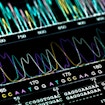In contrast to rare copy number variants (CNVs) causing classical syndromes such as Smith-Magenis syndrome and Williams syndrome, recent studies have identified a class of rare CNVs associated with the risk of developing a wide variety of neurodevelopmental and neuropsychiatric features. Individuals affected by these variants often have carrier parents who are apparently unaffected or manifest only subclinical neuropsychiatric features. This makes genetic diagnosis, counseling and management of individuals affected by such CNVs difficult. Several identified CNVs of this category, including 16p11.2 deletion, 1q21.1 deletion, 15q13.3 deletion and 16p12.1 deletion, collectively account for about 20 percent of individuals with neurodevelopmental disorders. Although these CNVs confer higher risk for a disorder, alone they are not sufficient for the manifestation of the disorder. It is therefore essential to consider additional genetic factors that may account for the observed variability in manifestation of these disorders.


